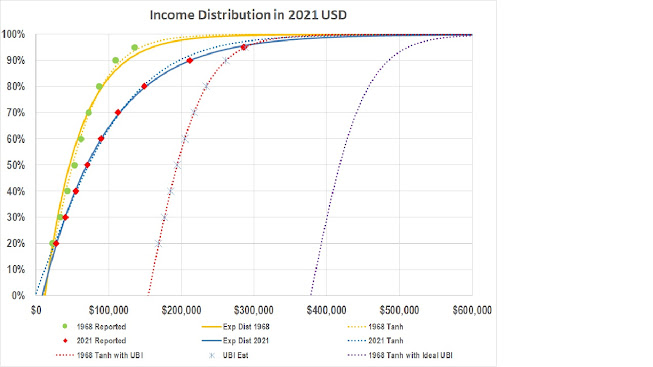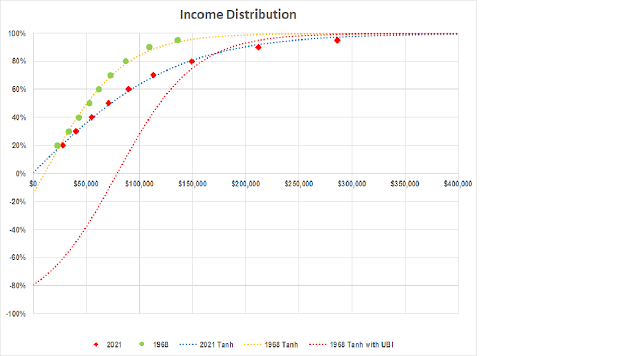Imagination
There is no
life I know
To compare with pure imagination
Living there, you'll be free
If you truly wish to be
Imagination may
be the key to the multiverse!
Is there a multiverse?
If there is, it must be a complex number, the sum of a real number and an imaginary number. Euler’s Formula is eix=cos(x)+isin(x),
in other words a complex number. This also means that as complex numbers, cos(x)=eix-isin(x),
and sin(x)=(eix-cos(x))/ i,
These can also be used to find values of cos2(x)
and sin2(x) as complex numbers.
cos2(x)=(eix-isin(x))2=
(eix)2-2isin(x)eix+sin2(x)
and
sin2(x)=((eix-cos(x))/i)2=
-(eix)2+2isin(x)eix-cos2(x)
Using Euler’s Formula, these can be restated as
cos2(x)=
(eix)2 -2isin(x)*( cos(x)+isin(x))+sin2(x)
or
cos2(x)=
(eix)2 +sin2(x)- 2isin(x)cos(x)
and
sin2(x)=
-(eix)2 +2isin(x)*( cos(x)+isin(x))
-cos2(x))
or
sin2(x)=
-(eix)2 -cos2(x)+2sin2(x)+2*isin(x)cos(x)
Therefore the formula for
a circle, 1=cos2(x)+sin2(x), as a complex
number is
-(cos2(x)+sin2(x)) +bi,
where b can be
any real number.
The formula for a
hyperbola, 1=cos2(x)-sin2(x), as a complex
number is
(cos2(x)-sin2(x)
)+ sin(x)(-4cos(x))i+ 2*(eix)2
The formula for a circle, cos2(x)+sin2(x)=1
is a real number. But if it were expressed
as a complex number, then the coefficient of its real component is a 90° rotation of that complex number
with any imaginary coefficient. The formula
for a hyperbola, cos2(x)-sin2(x)=1, is a
complex number, but it is also the coefficient of its real component, plus the coefficient of the imaginary number which
is the rotation by the angle of x of -4 multiplied by cos(x),
plus 2 multiplied by the square of Euler’s formula. If you apply the value for the square of
Euler’s formula, then the imaginary coefficient becomes a coefficient of zero.
(cos2(x)-sin2(x) ) + 2cos2(x) - sin2(x)+0i
The Euclidean, flat, surface is the
transition between a circle and a hyperbola.
Pythagoras’ formula relies on the formula for a circle, but saying that
the imaginary coefficient is zero does not mean that there is no imaginary coefficient.
Evidence of absence is not absence of evidence. There is a big difference
between a relative zero and an absolute zero.
IMHO the problem, is that the x property
describes a vector relationship to an absolute. A vector has both a magnitude AND a direction,
BUT that magnitude is never negative and the direction always points away from the
absolute. Analyzing its magnitude as a scalar
does not change those facts. You can have a magnitude of an equal amount in the
opposite direction, but this is NOT a negative magnitude in the same
direction. You have only appeared to create an new absolute, but you have not created
a new absolute. You have only reflected the old absolute.
The relationship to the absolute can be rotated around absolute
zero to create a solid which has dimensions of time, space and imagination. But that rotation does not change the
relationship to the absolute. There can
be the perception that there is negative space, etc., but this is only because
of the 2π rotation around the absolute to create an imaginary axis. The relationship of space, time, and
imagination is still with respect to the absolute.
Euler’s Formula describes a complex relationship including
an imaginary relationship, ix, not a real relationship.
Pythagoras’s Theorem is a real number, but it is also a rotation of the real
part of a complex number, which has an imaginary coefficient of zero.
IOW, Reality as a complex number is then -Reality +0i. If the Multiverse is a complex number which has the current universe as its real component, it must be Reality + bi. Thus the Multiverse excluding our current
universe is (b+0)*i.



